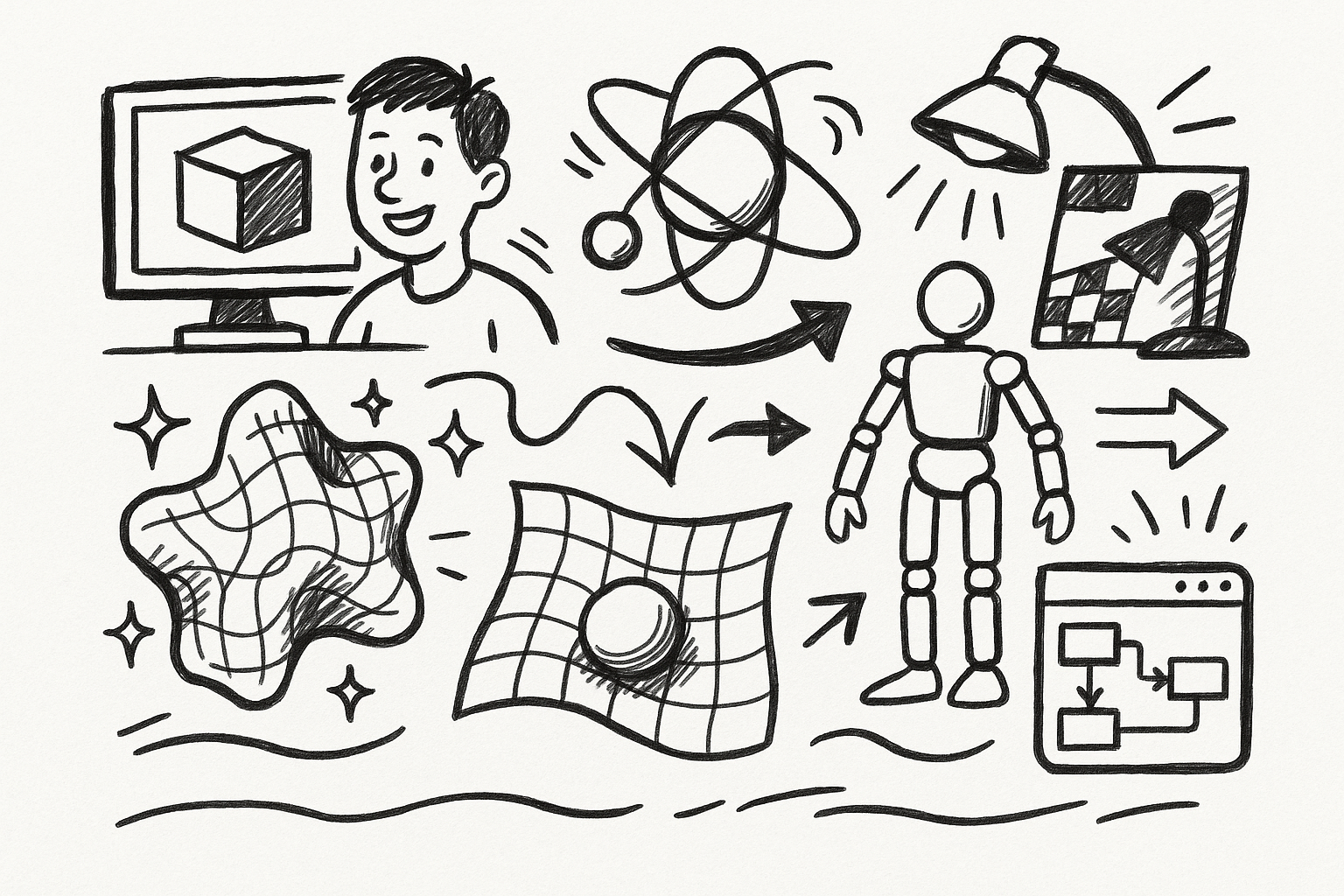Your Cart is Empty
Customer Testimonials
-
"Great customer service. The folks at Novedge were super helpful in navigating a somewhat complicated order including software upgrades and serial numbers in various stages of inactivity. They were friendly and helpful throughout the process.."
Ruben Ruckmark
"Quick & very helpful. We have been using Novedge for years and are very happy with their quick service when we need to make a purchase and excellent support resolving any issues."
Will Woodson
"Scott is the best. He reminds me about subscriptions dates, guides me in the correct direction for updates. He always responds promptly to me. He is literally the reason I continue to work with Novedge and will do so in the future."
Edward Mchugh
"Calvin Lok is “the man”. After my purchase of Sketchup 2021, he called me and provided step-by-step instructions to ease me through difficulties I was having with the setup of my new software."
Mike Borzage
Harnessing Edge AI for Transformative Design Processes: Real-Time Innovation and Efficiency
October 17, 2024 7 min read


In today's rapidly evolving technological landscape, the fusion of artificial intelligence (AI) with various industries has become a driving force for innovation and efficiency. Among these developments, the integration of Edge AI within design processes stands out as a significant advancement. Edge AI brings computation and data storage closer to the sources of data, which can be particularly beneficial in design environments where immediate feedback and real-time processing are crucial. As we delve into the world of Edge AI in design, we uncover how this technology is reshaping the way designers approach their work, leading to more intelligent, efficient, and responsive design processes.
Introduction to Edge AI in Design Processes
Edge AI, at its core, refers to the deployment of artificial intelligence algorithms and models directly on edge devices, such as sensors, machines, or local servers, rather than relying exclusively on centralized cloud computing resources. This paradigm shift allows for data to be processed and analyzed at the source of generation, enabling real-time insights and decision-making capabilities. In the context of design processes, Edge AI empowers designers to harness AI's capabilities without the limitations of latency, bandwidth constraints, or connectivity issues that are often associated with cloud-based solutions.
The importance of integrating Edge AI within design processes is multifaceted. Firstly, it enhances the efficiency of design workflows by providing immediate computational power at the fingertips of designers. This immediacy allows for rapid prototyping, testing, and iteration, which are essential components of modern design methodologies. Secondly, Edge AI contributes to the resilience and reliability of design systems. By decentralizing data processing, designers are less dependent on continuous internet connectivity and are safeguarded against potential disruptions in cloud services. This is particularly beneficial in high-stakes environments where downtime can lead to significant setbacks or losses.
The convergence of design and artificial intelligence marks a transformative era in the creative industries. AI is no longer an abstract concept confined to research labs but has become an accessible tool that can augment human creativity and problem-solving abilities. In design, AI algorithms can assist in generating design alternatives, optimizing parameters, and even predicting user preferences. When these AI capabilities are brought to the edge, the synergy between immediate computation and creative exploration becomes a powerful catalyst for innovation. Designers can interact with AI tools in real-time, fostering a more dynamic and interactive design process that pushes the boundaries of what is possible.
Applications of Edge AI in Design Software
The applications of Edge AI in design software are vast and varied, encompassing multiple disciplines and use cases. One of the primary benefits is the enhancement of real-time data processing capabilities, which significantly improves design workflows. For instance, during the design of a complex mechanical component, an engineer can receive instantaneous feedback on stress distributions or thermal properties as they adjust the model. This immediate feedback loop allows for rapid iteration and refinement, reducing the time from concept to final design.
Edge AI supports immediate feedback loops during design iterations by processing computationally intensive tasks locally. This reduces reliance on cloud-based computations, which can be hampered by network latency or bandwidth limitations. Designers can work more efficiently, knowing that the insights and analytics provided by AI are readily available without delay. This is particularly important in collaborative environments where team members need to make quick decisions based on the most current data.
Localized computation also enables faster decision-making by minimizing the delays associated with data transmission to remote servers. By handling computations on-site, Edge AI ensures that critical design decisions can be made promptly, which is vital in fast-paced industries where time-to-market is a key competitive advantage. Additionally, this approach enhances data security by keeping sensitive information within the local network, reducing the risk of data breaches or unauthorized access during transmission.
Edge AI's versatility is evident in its use cases across various design disciplines. In architectural design, for example, Edge AI can perform real-time building performance analysis, allowing architects to evaluate energy efficiency, structural integrity, and environmental impact as they develop their designs. This immediate analysis facilitates the creation of buildings that are not only aesthetically pleasing but also environmentally sustainable and compliant with regulatory standards. In the realm of product design, Edge AI enables customization based on user behavior by analyzing data collected from user interactions with prototypes or existing products. Designers can tailor products to meet specific user needs and preferences, enhancing customer satisfaction and loyalty.
In engineering simulations, Edge AI enhances the accuracy and relevance of simulations by incorporating on-site data inputs. Engineers can use real-time data from sensors embedded in machinery or infrastructure to inform their models, leading to more precise and actionable insights. This is crucial in industries such as aerospace or automotive engineering, where safety and performance are paramount. By leveraging Edge AI, engineers can proactively address potential issues and optimize designs before they become critical problems.
Benefits of Implementing Edge AI in Design
Implementing Edge AI in design processes brings about significant benefits in terms of efficiency, resource management, collaboration, and quality control. One of the most immediate advantages is the improved efficiency resulting from reduced latency and quicker response times. By processing data locally, designers no longer have to wait for computations to be performed on distant servers, which can be time-consuming and hinder the creative process. This immediacy accelerates the design cycle, allowing for more iterations and refinements within the same timeframe.
Another crucial benefit is the reduction in energy consumption through localized processing. Transmitting large volumes of data to and from cloud servers requires substantial energy, not only on the user's end but also within the data centers that handle these computations. By minimizing data transmission and performing computations on edge devices, the overall energy footprint of the design process is significantly reduced. This not only leads to cost savings but also aligns with sustainability goals, which are increasingly important in today's environmentally conscious society.
Edge AI enhances collaboration and communication by bridging gaps in remote design teams. With real-time data processing and sharing capabilities, team members can collaborate more effectively, regardless of their physical locations. This is particularly important in the current global context, where remote work has become more prevalent. Edge AI facilitates synchronized workflows, ensuring that all team members have access to the most up-to-date information and can contribute meaningfully to the design process.
Enhanced quality control is another key benefit of implementing Edge AI in design. By enabling real-time monitoring and analysis, Edge AI allows for the immediate detection of errors or anomalies in design outputs. This proactive approach to quality management reduces the likelihood of costly mistakes and ensures that the final product meets the highest standards of excellence. Designers can rely on Edge AI to provide continuous oversight, making the quality control process more efficient and effective.
In summary, the implementation of Edge AI in design processes leads to:
- Increased efficiency through reduced latency and faster computations.
- Resource optimization by lowering energy consumption and operational costs.
- Improved collaboration, enabling seamless communication among remote teams.
- Enhanced quality control with real-time monitoring and immediate issue resolution.
Challenges and Future Directions
While the advantages of Edge AI in design are significant, there are challenges that need to be addressed to fully realize its potential. Technical and infrastructural hurdles can impede integration, with one of the primary concerns being data privacy and security. Processing data on edge devices increases the number of endpoints that need to be secured, raising the risk of vulnerabilities. Organizations must implement robust security protocols to protect sensitive design data from unauthorized access or cyberattacks.
Compatibility with existing design tools and workflows is another significant challenge. Many design environments rely on established software and processes that may not readily support Edge AI technologies. Integrating Edge AI may require substantial modifications to existing systems, investment in new hardware, or retraining of personnel. This can be a barrier for organizations with limited resources or those resistant to change.
Despite these challenges, the future directions of Edge AI in design are promising. One major trend is the growing role of Edge AI in autonomous design decision-making. As AI algorithms become more sophisticated, they can take on more complex tasks, reducing the cognitive load on designers and allowing them to focus on higher-level creative decisions. This could lead to AI-driven design suggestions, optimizations, and even the generation of design options based on specified criteria.
Further advancements in AI algorithms tailored for design applications are expected. These algorithms will be optimized for operation on edge devices, taking into account the computational limitations while maximizing performance. Innovations may include more efficient neural network architectures, compression techniques, and hardware accelerators designed specifically for AI workloads in design contexts.
Future developments may also encompass:
- Enhanced interoperability between Edge AI systems and traditional design tools.
- Standardization of protocols and frameworks to streamline integration.
- Improved user interfaces that make AI tools more accessible to designers without technical backgrounds.
- Expanded use cases, incorporating virtual and augmented reality for immersive design experiences.
Conclusion
In conclusion, the integration of Edge AI into design processes represents a significant leap forward in how design and technology intersect. By bringing computational power to the edge of the network, designers can benefit from real-time feedback, improved efficiency, and enhanced collaboration. The transformative potential of Edge AI is vast, offering the tools needed to meet the increasingly complex demands of today's design challenges.
Designers and organizations are called to action to explore and adopt Edge AI technologies. Embracing these advancements not only positions them at the forefront of innovation but also provides a competitive advantage in a rapidly evolving market. As Edge AI continues to develop, its impact on the design industry is expected to grow, leading to more intelligent, sustainable, and user-centric designs.
The future of design is undoubtedly becoming more data-driven and AI-augmented. As we move forward, the collaboration between human creativity and machine intelligence will shape the next generation of design solutions. By leveraging the capabilities of Edge AI, the design industry can unlock new possibilities, transform traditional workflows, and set new standards for excellence in design.
Also in Design News

Revolutionizing 3D Design: Exploring Five Groundbreaking Innovations in Cinema 4D
August 31, 2025 4 min read
Read More
Revolutionizing Telecommunications: The Rise of Advanced Design Software
August 31, 2025 16 min read
Read More
Cinema 4D Tip: Optimizing 2D Matte Integration with Projection Man in Cinema 4D
August 31, 2025 3 min read
Read MoreSubscribe
Sign up to get the latest on sales, new releases and more …


